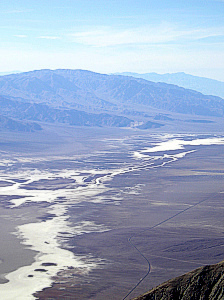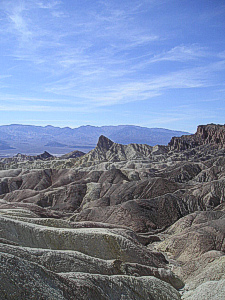|
These photos of Death Valley National Park (California) were shot on a magnificent day in April 2007.
|

|
A stop at Death Valley is a must of every trip through the historic Wild Far West of North America and there must exist millions of pictures of this place.
Yet adding a few more does not seam superfluous. Despite the desert-like harshness of the place, it is clearly alive and extremely mutable. Its look and mood changes with every slight change in the cloud cover or, regardless of clouds, with air humidity and the hour of the day, not to speak about seasons.
The 'river' you see in these pictures is formed by deposits of wet salt. Their wetness varies from point to point and from season to season, but rains are rarely sufficient to make them flow (it does happen sometimes during winter).
|

|

|

|
The lowest point of the valley, 85.5 meters below sea level, is also the lowest one in North America, but not in the world.
|

|
The following places on this planet's dry lands are located even lower:
- Dead Sea, Israel (-418 m), Sea of Galilee (-208 m),
and the Jordan River valley which connects them
- Lac Assal, Djibuti (-155 m)
- Turpan Pendi, China (-154 m)
- Quattara Depression, Egypt (-133 m)
- Kaspian Depression, Kazakhstan (-132 m)
- Afar Depression, Ethiopia (-125 m)
- Laguna del Carbón, Argentina (-105 m)
|



|

|
Zabriskie Point (this photo and the next one),
named after Christian Brevoort Zabriskie, who mined it in 1920's for borax !!!
Biologists tell us that, despite its appearances and its name, Death Valley is alive in the most literal of senses - there are many animal and vegetable species adapted to its harsh conditions. Adapted to the point that they could hardly survive anywhere else.
|

|
It is sure hard to imagine what can live here. Whatever it is, it might find Mars a luxury.
|

|
The Artist's Palette is a place where erosion has exposed a pocket of metal-containing minerals. In a sense, it should be too 'polluted' by heavy metals to be healthy. Except that they are all well mineralized (meaning they are included in stable, insoluble minerals).
Once there was a board here with the following text:
Various mineral pigments have colored these volcanic deposits. Iron salts produce the reds, pinks and yellows. Decomposing mica causes the green. Manganese supplies the purples. Colors on the 'palette' are reproduced in a larger scale on the mountains around the valley.
Click on the photo to view it with enhanced colors.
|

|
The one species which adapts to everything is Man. If this were not a protected National Park area, I am sure that it would be already plastered all over by fancy 'development' projects and teaming with city joggers.
This photo is by Paola Bertani.
The texts are by Stan Sykora.
|
| |
|